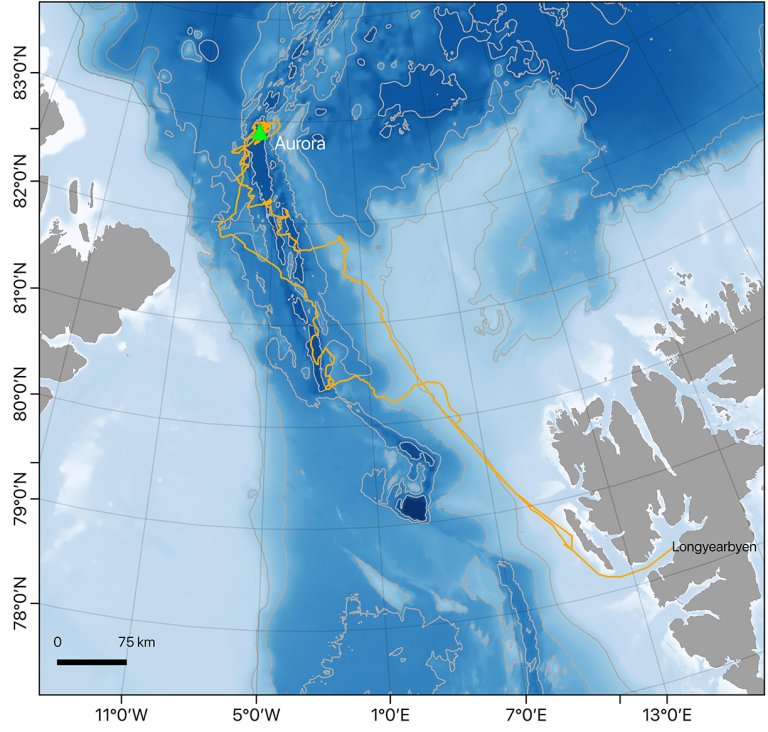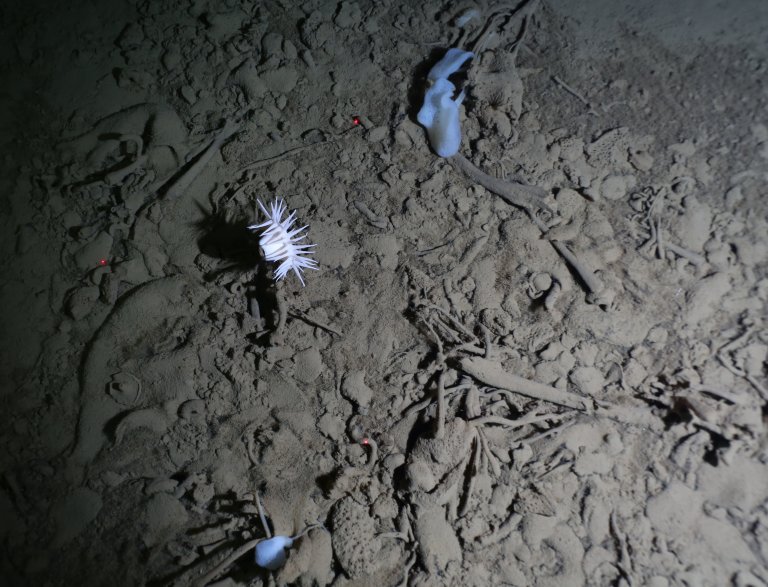
Searching for Aurora on the Gakkel Ridge
"Aurora is a seamount on the ocean floor, a volcanic structure containing hydrothermal vents . It can be found on the 83N on the Gakkel Ridge which forms a tectonic plate boundary between the North American Plate and the Eurasian Plate. The Aurora is on this ridge, 4 km below the surface of the ocean, and it is permanently covered by sea ice. The air temperature in the area was as low as -20C when we were there and demands on technology and crew are huge. Therefore, the area is not very well examined at all”, says professor Stefan Buenz of CAGE, chief scientist for the expedition that took place in September 2019.

Black “smoke” from ocean chimneys
It is mainly its unapproachability that made Gakkel Ridge so interesting for the scientists in the first place. The new Norwegian icebreaker RV Kronprins Haakon and deep-sea camera and ROV technologies from the Alfred Wegner Institute (AWI, Germany) and the Woods Hole Oceanographic Institution (WHOI, USA) made it possible for the seamount to be examined. The HACON expedition aimed to examine hydrothermal vents on Aurora, that were first recorded in 2014 by the scientific expedition PS 86 onboard icebreaker RV Polarstern. The expedition, led by Dr Antje Boetius (AWI), was first to capture a brief but tantalizing video of the black smoker on Gakkel Ridge.
“Ours was a high-risk, high-gain type of expedition. Anything could go wrong. But any new observations and samples would greatly increase our understanding of exotic ecosystems that are fueled by energy from the interior of the Earth, existing in the darkness four kilometers away from the ocean surface, and covered by sea ice”, says the coordinator of HACON-project, Eva Ramirez-Llodra from the Norwegian Institute for Water Research and REV Ocean.
At mid-ocean ridges such as Gakkel Ridge, the cold seawater penetrates through cracks on the seafloor. It gets heated by the magma chamber beneath the ridge, and its chemistry is modified. This scorching fluid (normally around + 350°C) is then expelled back into the water column. As it gets in contact with the cold and oxygenated deep-sea water, it appears as black smoke coming out of chimneys.
A pathway for exchange of genetic material
The chemicals in these fluids, such as hydrogen sulphide or methane, are used as source of energy by micro-organisms in this pitch-dark world, to produce organic matter. It works in the similar way as plants on land use solar energy for photosynthesis. This is called chemosynthesis and it sustains the exotic animals that thrive at hydrothermal vents.
“Our hypothesis was that the Gakkel Ridge provides a connecting pathway for gene flow between the Pacific and Atlantic oceans, with species moving from vent to vent along the ridge in their larval form, braving many obstacles in the ocean. The data collected from this cruise will help improve our understanding of this process and the role of the Gakkel Ridge in the global distribution of different vent species”.
From the Arctic smokers to life on frozen moons
Nadia Drake, a writer for National Geographic and Luis Lamar director of photography for Avatar Alliance Foundation (funded by the director James Cameron) were in for the entirety of the expedition, spending a month on the ship getting in and out of sea ice.
You can read the National Geographic Magazine article here
Vent related microbiology and chemical components in the sea ice were of interest for astrobiologists from NASA JPL, and a microbiologist from UiT, who are developing programs to look for life on the frozen oceans of moons like Enceladus or Europa.
“There were eleven scientific institutions represented on the cruise, with focus on life in ice-covered oceans. Ecology, micropaleontology, oceanography, geochemistry, you name it we had it on the cruise. But astrobiology was a completely new field for me, with an interesting perspective!” says Buenz, who himself is a geophysicist.

Nerve-wrecking days in the ice
The scientists are gushing about the great collaboration within the scientific team and media on board, and the exceptional skills of the officers and crew. They are, however, still shaky from the encounters with the sea ice – which was non-collaborative to put it mildly.
«Every day was a planning headache. We were in the sea ice and the ice is constantly moving with formidable and extremely unpredictable force. The ice may look flat and uniform, but the floes crack, thaw and refreeze, making the ice several meters thick in some places and paper-tissue thin in others”, says Stefan Buenz.
Working on the vent site - while drifting with the ice - was like looking for a needle in a haystack.
However, the ice conditions were often favorable, and the scientists could submerge a high definition camera over the black smokers, taking invaluable video and high definition images that will allow them to better understand these remote ecosystems.
«By the end of the expedition there was a huge ice floe on top of the vent that would not move away. For three days we waited patiently, but we had to give up eventually and exit through a labyrinth of ice floes. It has been a challenging, rewarding and successful cruise and we will definitely do it again”, Eva Ramirez-Llodra concludes.